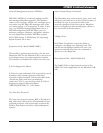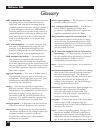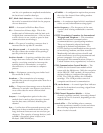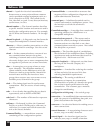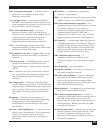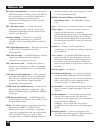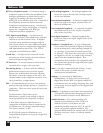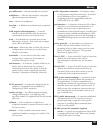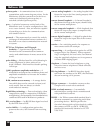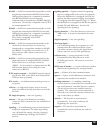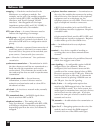
telephone interface connector — A termination on
the voice/fax module that connects the analog
side of the voice/fax channel to the telephone
equipment such as a telephone set, key
telephone system, or voice PBX. There are two
types of telephone interface connectors:
• RJ-11 6-pin modular jack, used for KTS and
OPX telephone interface equipment. Requires
a modular cable.
• 8-pin terminal block, used for KTS, OPX, and
E&M telephone interface equipment. Requires
a cable made up of 8 color-coded wires.
telco — An abbreviation for any telephone
company.
terminal — Any device capable of sending or
receiving data over a data-communications
channel.
timeout — The expiration of a predefined interval
which then triggers some action.
tone signaling — A configurable option in E&M-
strapped voice/fax channels. When so
configured, the local channel senses an idle
condition of the remote channel when a 2280-
Hz tone is present on the T1-R1 pair. When the
local channel is in an idle state, it informs the
remote channel by placing a 2280-Hz tone on
the T-R pair. See also DC signaling.
2-wire/4-wire — A configuration option that
matches the E&M-strapped voice/fax channel
with the PBX tie trunk. In a 4-wire system, the
audio signal is transmitted over one pair of wires
and received over the other pair. In a 2-wire
system, the same pair of wires is used for both
transmit and receive.
TX, transmit — An abbreviation for transmission or
transmitting.
Types I to V — Strapping options on the voice/fax
module used to match the E&M-strapped
channel with one of five PBX trunk types.
Multiserver 5000
262
strapping — A hard-wire method used in the
Multiserver to configure a module. For
example, on the voice/fax module strappable
options include KTS, OPX, and E&M telephone
interfaces, and Types I through V E&M
interfaces. Also strappable are the input
impedance options (600, and U.K./COMP) in
the international voice/fax modules.
STX, start of text — A control character used to
indicate the beginning of a message.
switch group — A group of switches encased in a
block mounted on a printed circuit board. It is
also called a DIP switch or configuration switch
group.
switching — Selective, requested interconnection of
same-class ports on local and/or remote nodes.
Async and voice/fax ports can be switched; sync
ports cannot. Contrast with force connection.
sync — Short for “synchronous.” See synchronous
transmission.
synchronous transmission — Transmission in which
the data characters and bits are transmitted at a
fixed rate with the transmitter and receiver
synchronized. This eliminates the need for the
start and stop bits that are used in asynchronous
transmission.
SYN, synchronous idle — In synchronous
transmission, a control character used to
maintain synchronization and as a time fill in
the absence of data.
tail circuit — A circuit to a network node, normally
a leased line.
TD, transmitted data — An RS-232 signal where
data is sent from DTE to DCE.
telephone interface — The analog side of a
voice/fax channel. Compatible with KTS, OPX,
or E&M type telephone interface equipment,
depending upon how the voice/fax channel is
strapped.



